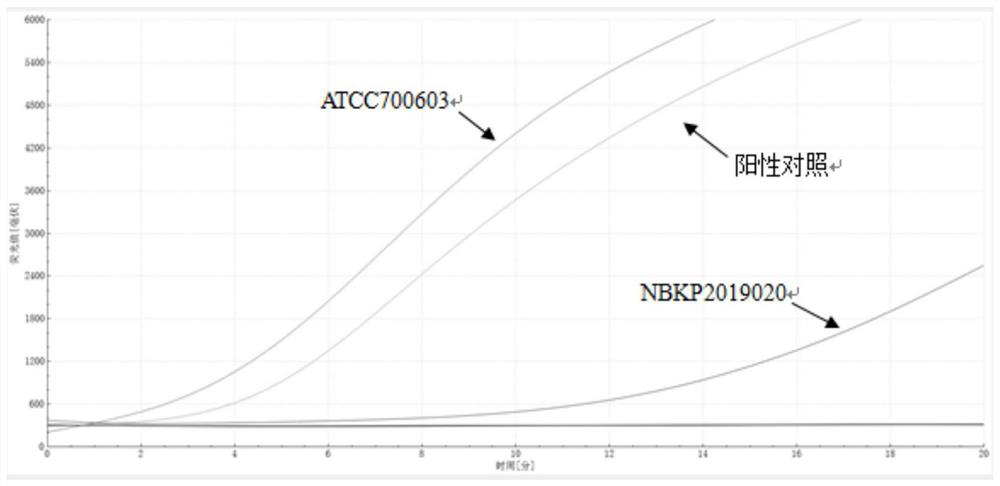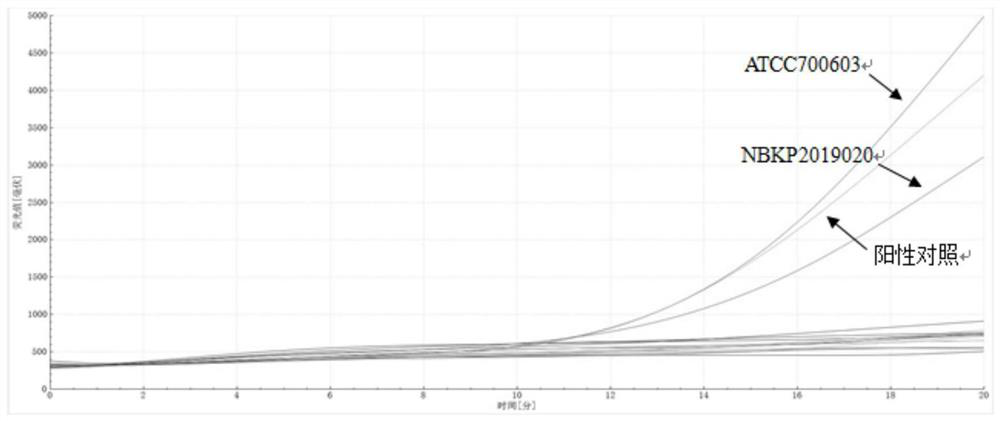Primer and probe sequence for klebsiella pneumoniae fluorescence RAA detection and application
A technology of Klebsiella pneumoniae and probe sequence, applied in the direction of microorganism-based methods, biochemical equipment and methods, DNA/RNA fragments, etc. Focus on issues such as sequence to achieve the effect of controlling the epidemic and gaining time, strong specificity, and ensuring reliability
- Summary
- Abstract
- Description
- Claims
- Application Information
AI Technical Summary
Problems solved by technology
Method used
Image
Examples
Embodiment 1
[0022] For the specific conserved region of Klebsiella pneumoniae as the target region, specific primers and fluorescent RAA probes were designed: the forward primer was 5'-TGGCCGGTTGCGTACAGGTTGATCGTTATGA-3';
[0023] Reverse primer: 5'-AGGGAAGCGGTCACGTTGTAGATCTCACTGTCAC-3'; Oligonucleotide probe:
[0024] 5'- CAAACGAAAGGGCCGCAGAGCGCGATGA (FAM-dT)G(THF)G(BHQ-dT) CCTGACGCCATTG -3';
[0025] Among them: FAM: 6-carboxyfluorescein; THF: tetrahydrofuran; BHQ: black hole quencher; phosphate: phosphorylation at 3' to stop extension.
Embodiment 2
[0027] A fluorescent RAA method for detecting Klebsiella pneumoniae, comprising the following steps:
[0028] 1. Extraction of sample DNA: Klebsiella pneumoniae standard strains and isolated strains were expanded in LB medium for 18-24 hours, and DNA was extracted using DNA extraction reagent (cador Pathogen 96QIAcube HT kit, Kaijie Company, Germany). Aliquot and store at -80°C;
[0029] 2. Use the DNA of the sample to be detected as a template, add RAA reaction solution, enzyme mixture, etc. to form an RAA reaction system, and perform an amplification reaction. The reaction system is as follows: 25 μl RAA reaction buffer; forward primer, reverse primer (10 μM ) 2.1 μl each; 0.6 μl probe (10 μM); 2 μl DNA template; add 15.5 μl double distilled water to 47.5 μl, mix well, and then add to dry powder (containing recombinase, single-strand binding protein, DNA polymerase, reaction buffer solution, dNTP, etc., in the reaction tube of RAA Nucleic Acid Amplification Kit (Fluorescenc...
Embodiment 3
[0037] Standard strains, clinical isolates detection experiment
[0038]This experiment verifies whether this detection method can detect bacterial standard strains, and adopts the above-mentioned embodiment 2 method to detect the Klebsiella pneumoniae standard strain ATCC 7000603 that is in the logarithmic growth phase through LB medium expansion culture, and concentration is about 5×10 8 CFU / ml, experimental results refer to figure 1
PUM
 Login to View More
Login to View More Abstract
Description
Claims
Application Information
 Login to View More
Login to View More - R&D Engineer
- R&D Manager
- IP Professional
- Industry Leading Data Capabilities
- Powerful AI technology
- Patent DNA Extraction
Browse by: Latest US Patents, China's latest patents, Technical Efficacy Thesaurus, Application Domain, Technology Topic, Popular Technical Reports.
© 2024 PatSnap. All rights reserved.Legal|Privacy policy|Modern Slavery Act Transparency Statement|Sitemap|About US| Contact US: help@patsnap.com









